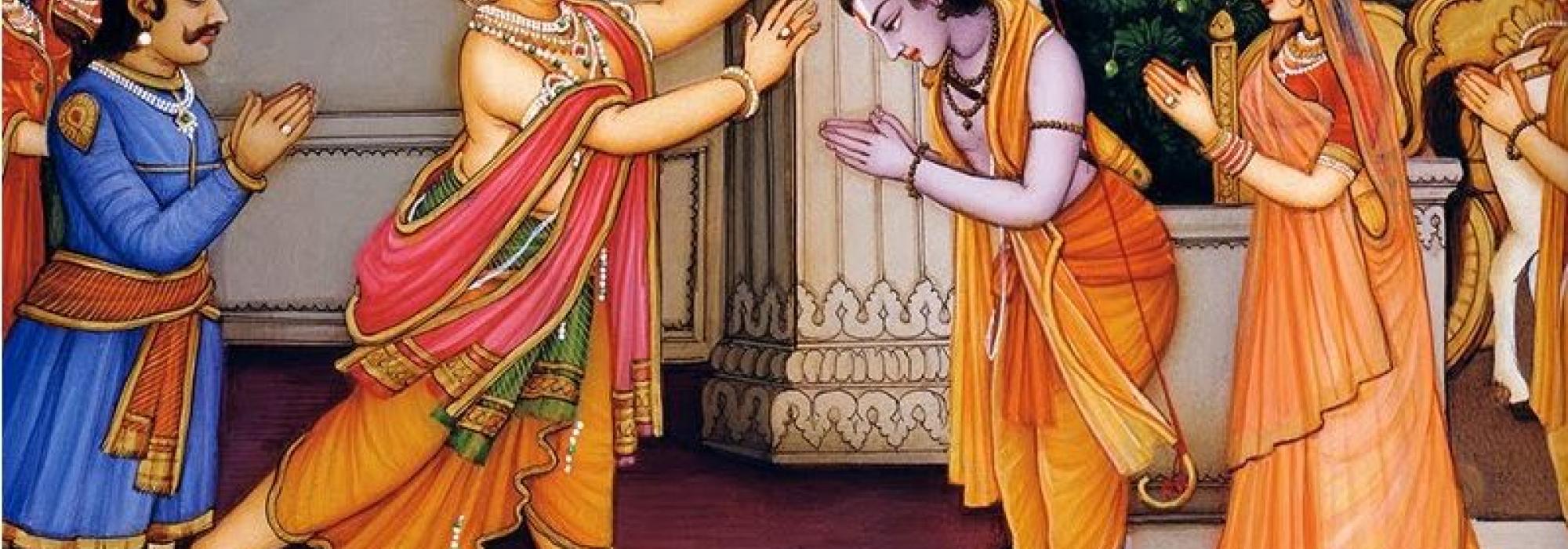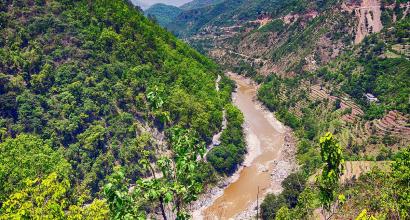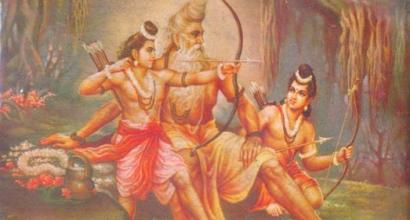A brāhmaṇa by name Trijaṭa who belonged to the Gārgya-gotra approached Rāma and told him about his poverty. He had many children and subsisted his family through uñcha-vṛtti. He requested Rāma for help. Rāma promised him, “I have not given away even a thousand cows. Throw your staff to a distance. You will get as many cows as covered by your staff.” Excited, Trijaṭa tied his upper garment to his waist, whirled his stick above his head, and flung it with all his strength. It fell at a great distance. Rāma begged for Trijaṭa’s excuse for testing his strength and assured that he had done so only playfully. He offered him a huge heard of cows. The brāhmaṇa blessed Rāma and left happily with his wife.
~
Rāma along with Sītā and Lakṣmaṇa headed to see their father Daśaratha. As they were passing through the streets, Ayodhyā’s citizens climbed on the top stories of their houses and looked at them with immense grief. They spoke to each other thus, “Rāma, who used to be accompanied by the four-fold army, is now followed by only one man – Lakṣmaṇa. Sītā, who was hard to be spotted even by beings in the sky is now being spotted by every common man, as she walks on the street. It appears like Daśaratha is possessed by some evil spirit. Even a worthless son is never exiled by the father, let alone a person who has won the heart of the world through his conduct. Rāma is an embodiment of six supreme qualities – kindness, compassion, knowledge, nobility, self-control, and a calm mind. He does not want to falsify his father’s words. The world is going to suffer just as a tree whose roots are injured when it is about to bear fruits and flowers. Like Lakṣmaṇa, let us follow him with our wives and children, abandoning our fields and gardens. Let us be with him in his joys and sorrows! Kaikeyī may then gladly rule the empty kingdom that is deserted by the gods and is filled with vacant houses. The forest will be our city and may the city, abandoned by us, turn into a forest!”
Rāma heard these words but remained unperturbed. He entered his father’s palace and asked the woe-stricken Sumantra to inform his father of his arrival. Sumantra conveyed to Daśaratha Rāma’s giving away of wealth and his decision to go to the forest. Upon Daśaratha’s instruction Sumantra summoned all the three hundred and fifty wives of the king. Their eyes were red with sorrow as they followed Kausalyā. As Rāma entered the court, loud cries of sorrow were heard. Daśaratha got up to welcome his sons but fell down unconscious. Weeping, Rāma and Lakṣmaṇa, helped him up and seated him on the couch. Rāma made his decision known to the king and sought his permission to let Sītā and Lakṣmaṇa accompany him as well.
Daśaratha exclaimed, “O Rāghava! I have been deceived by Kaikeyī through her demands of boons. You may imprison me and become the king of Ayodhyā right away.” Rāma calmed him down and reiterated his firm decision. Daśaratha said, “Go, my child, and return having achieved immense glory. But, please don’t go today. It is already night. Let me please you with everything you desire. You may leave tomorrow morning!”
Rāma said, “Who can assure that I will have today’s quality tomorrow as well? Therefore, departing today is the best thing I could ask for! I am not asking for the kingdom, the pleasures or life, and not even Maithilī. I just want to ensure that you will be considered an honest person in your promises. I will enjoy the beautiful trees in the forest as well as the mountains, rivers, and lakes. I will subsist on fruits and roots. Please set your mind in peace!”
Daśaratha instructed Sumantra to make arrangements for a large army and hunters to follow Rāma. He also wished to send the wealth of the treasury and granary to be sent along. Upon hearing this, a distressed Kaikeyī, with her face burning, snapped at the king, “Bharata will not accept a kingdom that is empty of its wealth and devoid of its people!” A pained Daśaratha called the shameless Kaikeyī a curse on his life. With increased asperity, Kaikeyī went on a tirade of Daśaratha’s ancestors. She quoted the example of Asamañjas, the eldest son, who was exiled by his father Sagara. An old minister by name Siddhārtha recounted the insane deeds of Asamañjas, who threw children in the waters of river Sarayū and added that King Sagara sent him on a life-long exile upon the behest of his citizens. He asked, “What is Rāma’s offence to have him exiled?”
Helpless, Daśaratha declared, “I will go with Rāma right away giving up my kingdom, wealth, and happiness. You may enjoy the kingdom as you like with your son Bharata!”
Rāma said, “What will I do with all the wealth and army in the forest, O father! Let them bring tree-bark for clothing as well as a pair of hoes and baskets, as I will need to dig for roots and shoots!” Thereupon, Kaikeyī herself went, brought tree-bark, gave it to Rāma, and commanded him to wear it. Right there, amidst everyone assembled, Rāma removed his fine garments and put on the garments of a muni. Lakṣmaṇa too did the same.
On seeing the bark that had been brought for her to wear, Sītā, who was clad in silk, was frightened like a doe that sees a snare. She received the bark garment from Kaikeyī and with her eyes filled with tears, asked Rāma, “How do munis wear this?” The daughter of Janaka held up the garment to her neck and stood confused. Rāma immediately went to her and draped her in bark over her silk clothes. Looking at Sītā who, though married to her lord, was like an orphan, everyone denounced Daśaratha! Heaving a hot sigh, the king said, “Kaikeyī! Sītā shall not go clad in this bark-garment. Don’t your wicked deeds end with exiling Rāma to the forest, you vile one! Why do you want to add to your sins by committing these additional atrocious deeds?”
Rāma dissuaded Daśaratha from accompanying him by asking to him to take care of his god-like wife Kausalyā. Daśaratha lamented, “I see my son standing in front of me like blazing fire. Thanks to Kaikeyī’s selfish deeds, the whole world is going to suffer.”
Upon Daśaratha’s command a splendid chariot with horses was brought for their departure. Daśaratha offered brilliant clothes and jewellery to his beloved daughter-in-law and Sītā decked herself with them. Sītā sought Kausalyā’s blessings and was advised by her about the qualities of a noble wife. Rāma went in a pradakṣiṇa around his mother and assured her, “I will be back right after fourteen years, O mother! The years will pass like a night you had slept through.” With his hands folded, Rāma addressed his three hundred and fifty mothers, “If I have ever said anything harsh because of my familiarity with you or done something out of my ignorance, please excuse me!” The palace of Daśaratha that once resounded with the sacred sounds of muraja and paṇava, was now filled with wailing, plunged in great grief because of the unimaginable tragedy.
Rāma, Sītā, and Lakṣmaṇa performed pradakṣiṇa to Daśaratha. Rāma and Sītā touched the feet of Kausalyā and Lakṣmaṇa of Sumitrā. Just before they left, Sumitrā advised Lakṣmaṇa, “Look upon Rāma as Daśaratha, Jānakī as me, and the forest as Ayodhyā. Farewell, my child, be happy!”
~
Rāma, Sītā, and Lakṣmaṇa climbed on to the chariot that was driven by Sumantra. The entire city including old men and children ran after Rāma just as those parched by summer’s heat go after water. Their faces full of tears, they called out to the charioteer, “Rein in the horses! Go slow! Let us look at Rāma’s face, which we shall not see for long! Surely, the heart of Rāma’s mother is made of iron – it does not seem to shatter even upon seeing her god-like son going away! Vaidehī is indeed blessed to follow her husband like a shadow, and Lakṣmaṇa, you have obtained your heart’s desire!”
Daśaratha rushed out of his residence calling out to his dear sons. Rāma saw his mother Kausalyā, running behind the chariot on unsteady feet as if she were dancing. She repeatedly called out “O Rāma! O Sītā, Lakṣmaṇa!” Rāma instructed Sumantra to drive the chariot faster, unable to bear the sight of his grieving parents. The king called out to Sumantra to stop. The charioteer’s mind was as though stuck between two wheels, receiving contrary instructions from father and son. Sumantra drove the chariot with increased speed even as loud cries were heard from the city. Daśaratha’s ministers advised him not to follow Rāma a long way if he was hoped to return, and stopped him from chasing the chariot.
As Rāma went beyond their sight, the citizens cursed Daśaratha and Kaikeyī. No one performed their household chores; elephants did not eat their food and the cows did not offer milk to their calves. No cool winds blew nor was the moon seen; the sun did not shine and the world was in chaos.
To be continued...
[The critically constituted text and the critical edition published by the Oriental Institute, Vadodara is the primary source. In addition, the Kannada rendering of the epic by Mahāmahopādhyāya Sri. N. Ranganatha Sharma and the English translation by Sri. N. Raghunathan have been referred.]











































